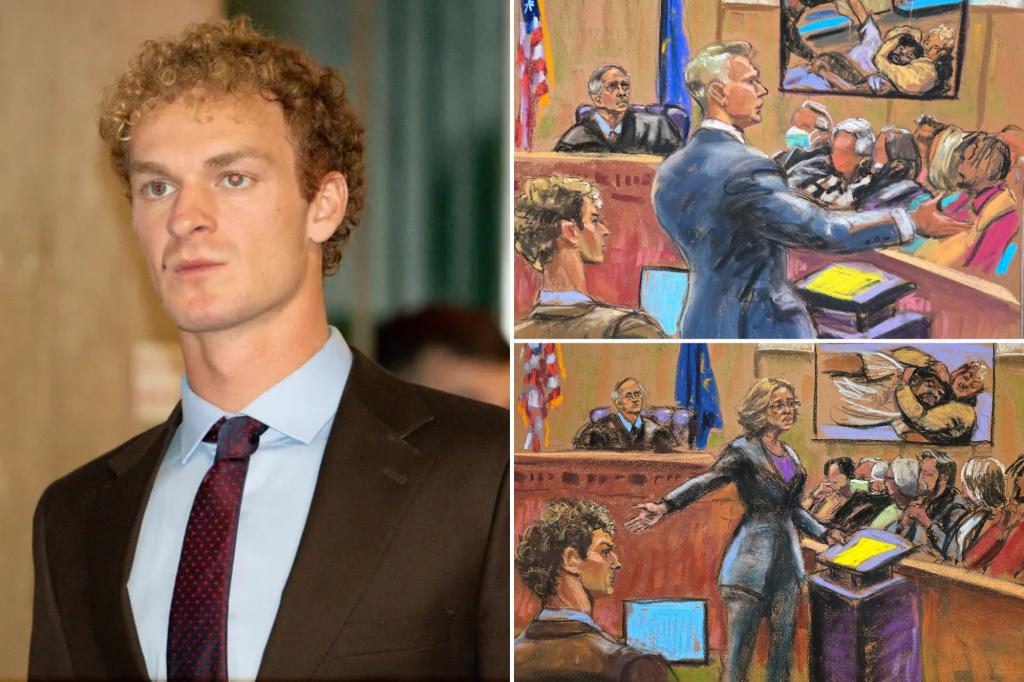The trial of Daniel Penny, a 26-year-old Marine veteran charged with manslaughter and criminally negligent homicide, revolves around a fatal encounter on a subway train with Jordan Neely, a 30-year-old homeless man suffering from mental illness and drug addiction. During the closing arguments in Manhattan Supreme Court, Penny’s defense attorney, Steven Raiser, framed Penny’s actions as a response to an immediate threat to fellow subway riders. Raiser posed a rhetorical question to the jurors, asking who they would prefer to be on a subway train with: a passive bystander or someone like Penny who would take action. The implication was clear: Penny’s intervention was not only bold but necessary, as he attempted to protect others from Neely’s aggressive behavior, which witnesses described as menacing and unhinged.
In stark contrast, Assistant District Attorney Dafna Yoran argued that Penny’s response was excessive and criminal. Yoran emphasized that while Penny’s initial restraint of Neely might have been defensible due to Neely’s capricious threats, he went too far by maintaining the chokehold for six minutes, including a significant duration after Neely lost consciousness. This prolonged use of force sparked a broader societal question about accountability and the sanctity of human life. Yoran firmly stated that “no one had to die” during the encounter, highlighting the myriad ways Penny could have subdued Neely without resorting to a fatal chokehold, which violated both legal standards and basic human decency.
The defense’s narrative sought to characterize Penny as a conscientious protector acting under difficult circumstances. Raiser emphasized that Penny had received military training that equipped him not just for combat but for situations requiring rapid judgment in protecting civilians. However, Yoran countered this sentiment by bringing to light the realities of Penny’s actions that deviated from his training. The prosecution insisted that a Marine veteran should have recognized more appropriate ways to manage an unarmed individual rather than resorting to excessive force. By framing Penny’s involvement as reckless rather than heroic, the prosecution aimed to dismantle the defense’s portrayal of him as a savior.
The arguments presented by both sides reflected contrasting perspectives on the use of force in public spaces and the morality of intervening in potentially life-threatening situations. Raiser attempted to humanize Penny by sharing personal details about his life and interests, such as his love for surfing and his academic pursuits in architecture, aiming to present him as a multifaceted individual rather than a villain. He further referred to Penny’s actions not as a chokehold but as “civilian restraint,” a term intended to diminish the severity of the act. This choice of words was an effort to evoke a more compassionate understanding of the circumstances surrounding the incident while attempting to limit the implications of the charges against Penny.
While Raiser painted a sympathetic picture of Penny, the prosecutor persisted in reinforcing the idea that the defendant’s actions had irreversible consequences. The courtroom atmosphere was charged, with demonstrators outside the courthouse calling for justice. Their chants of “Guilty! Guilty! Guilty!” underscored the societal tensions surrounding homelessness, mental illness, and public safety that the trial spotlighted. The incident, and the ensuing courtroom drama, raised questions about societal responsibilities to individuals facing mental health challenges and the boundaries of personal safety in public spaces.
As the trial came to a close, jurors were left to deliberate on the ethical and legal implications of Penny’s actions. The case exemplified the complexities inherent in determining when intervention is justified and the parameters of such actions in a dynamic public environment. Both sides presented compelling arguments that hinted at the larger societal issues of mental health, public safety, and individual rights that reverberated far beyond this courtroom. Ultimately, the jury’s decision will not only impact Penny’s future but also reflect the community’s stance on how to navigate the convoluted relationship between fear, protection, and humanity in shared spaces.

